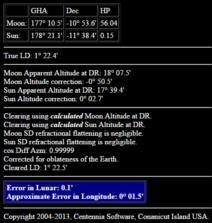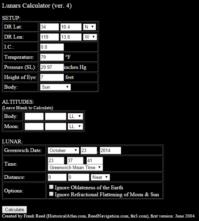
NavList:
A Community Devoted to the Preservation and Practice of Celestial Navigation and Other Methods of Traditional Wayfinding
From: UNK
Date: 2014 Oct 24, 06:18 +0100
Fantastic Greg.
Very jealous, we had nothing in UK . I’m being very dim, but how did you measure the 17.5’ and 35.5’ LDs from the telescope pictures? I’m only just starting to get into astronomy with telescope and want to start taking pictures of lunar eclipses and Jupiter moons for longitude.
Re Newton’s era. The Greenwich Museums have produced a great book “Finding Longitude” (available cheaper from Amazon, beautifully illustrated and full of interesting history on lunars) to go with the current longitude exhibition. Page39 states that In 1713, Newton reported to Parliament that Jupiter’s moons , using latest Casini and Flamsteed tables gave accurate longitude on land, but that lunar theory (his! Gave him a headache!) was still not good enough to give longitude from eclipses better than 2-3 degrees. Page 28 however describes a fairly accurate longitude of Charlton Island, Canada, from lunar eclipse recorded by Welsh explorer Thomas James in 1631.(later compared to London observations to give the longitude). I’m not sure when predictions of lunar eclipses became accurate enough for 1 degree accuracy, presumably before Mayer’s accurate tables for LDs in the mid 1700s? But France had been re-mapped (and shrunk!) using Jupiter moon/Casini based longitudes by 1700.
Fascinating stuff!
Francis Upchurch
From: NavList@fer3.com [mailto:NavList@fer3.com] On Behalf Of Greg Rudzinski
Sent: 24 October 2014 01:06
To: francisupchurch@gmail.com
Subject: [NavList] Re: Big fat sunspot and a solar eclipse
I said good bye to this partial eclipse with one final binocular lunar observed at the moment of extinguish. Judging by todays results I would say that astronomers from Newton's era should have been able to nail longitude on land by observing an eclipse with a telescope.
Greg Rudzinski
Attached File: 
(Partial-Solar-Eclipse-Lunar-.PNG: Open and save)
Attached File: 
(f1-Partial-Solar-Eclipse-Lunar-.PNG: Open and save)






